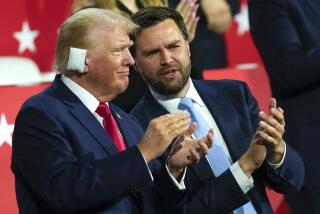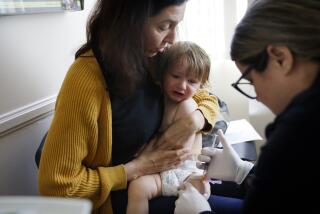Doing the Right Thing for the Kids : Congress needs to fund, and drug firms cooperate with, move to vaccinate more children
- Share via
Newborn babies are routinely vaccinated, and state laws require that children have a full range of immunizing shots before they are allowed to start school. It is the years between birth and 5 or 6 that for many constitute a danger zone. In big cities, up to half of all 2-year-olds lack full protection against measles, rubella, mumps and other infectious diseases. Here is one area among a number where the nation’s enormous investment in health care fails to meet basic needs. The other day Hillary Rodham Clinton noted that in all of the Western Hemisphere, only Bolivia and Haiti have lower immunization rates than this country. Her husband, the President of the United States, has now acted to do something about that shocking fact.
President Clinton will ask Congress to appropriate $300 million more this year to make vaccination services more widely available. This could be the most consequential act so far of his young Administration. The money would pay for more vaccines and more health workers, and allow public clinics--where about half the nation’s children get their shots--to keep longer hours. The White House estimates that the program could lead to the immunization of about another 1 million children this summer.
Cost is a major reason that so many children are left unimmunized. In the last decade, Clinton says, the price of vaccines has risen at six times the rate of inflation. Ten years ago immunization for a child at a private facility cost $23; the cost today is more than $200. At public clinics the cost has gone from $7 to more than $90. Small wonder that the parents of so many young children are unable to afford basic preventive care.
To try to get costs under control Clinton has directed Health and Human Services Secretary Donna Sha- lala to negotiate with drug manufacturers for more affordable prices for state bulk purchases. Drug companies have negotiated discounts with 10 states, but balked at extending the policy to others. The drug makers say their high costs reflect the expenses of research and development, and such extras as the excise tax the government put on vaccines in 1986 to compensate for children injured by adverse reactions to the drugs. Clinton’s response is that the industry spends $1 billion a year more on advertising and lobbying than it does on new drug development and that its profits “are rising four times faster than those of the average Fortune 500 company.” Clearly there is room for significant cost-cutting on the most commonly used vaccines.
Immunizations are the first line of preventive medicine, a key measure of public health. Clinton is to be applauded for his initiative to protect so many of the nation’s children. The next step is for Congress to act swiftly to fund it.
More to Read
Sign up for Essential California
The most important California stories and recommendations in your inbox every morning.
You may occasionally receive promotional content from the Los Angeles Times.










